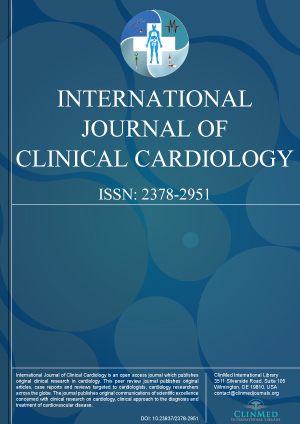Open Access DOI:10.23937/2378-2951/1410211
Incidence of Left Ventricular Systolic Dysfunction in Asymptomatic, Incidently Detected Left Bundle Branch Block (LBBB) in Apparently Healthy Individuals: A Prospective Observational Study at a Tertiary Care Cardiac Center in North India
Sheikh Jan Mohammad, MD, DNB, AM-ACC/AHA, Mohammad Tahir Ganaye, MD, Samiera Hassan3 and Nusrat Bashir
Article Type: Original Research | First Published: December 31, 2020
Left bundle branch block (LBBB) is often associated with significant heart disease and is often the result of myocardial injury, strain or hypertrophy, it can also be seen in patients without any particular clinical disease. The significance of LBBB has not been well studied in subjects without myocardial infarction or pre-existing heart failure. Therefore, we sought to study the incidence of LV systolic dysfunction in asymptomatic, incidentally detected LBBB in apparently healthy individuals. A...
Open Access DOI:10.23937/2378-2951/1410210
Changes and Outcome of Cardiac Function in Children with SARS-CoV-2 Multisystem Inflammatory Syndrome
Chloé Huet, MD, Thibault Blache, MD, Thomas Perouse de Montclos, MD, Claire Bertail Galoin, MD, Cécile Leconte, MD, Mohamed Bakloul, MD, Etienne Javouhey, MD, PhD, Elodie Perdreau, MD and Sylvie Di Filippo, MD, PhD
Article Type: Original Article | First Published: December 26, 2020
Cardiac involvement has been reported in children with SARS-CoV-2 inflammatory syndrome. The objectives herein were to assess changes in cardiac parameters and compare cardiac pathologies observed in SARS-CoV-2 to Kawasaki-(KW) and myocarditis-(MY). Patients < 18 years of age, with symptoms of Kawasaki disease (KW group) and/or of acute myocarditis (MY group) from March 1 to May 31 2020 were included. Clinical, laboratory data, and cardiac parameters were recorded upon diagnosis and at several p...
Open Access DOI:10.23937/2378-2951/1410209
Balloon Induced Dissection of Left Anterior Descending Artery and its Bidirectional Progression Involving Left Circumflex Artery
Santosh Kumar Sinha, FACC, FAESC, FSCAI, Puneet Aggarwal and Umeshwar Pandey
Article Type: Case Report | First Published: December 12, 2020
Coronary artery dissection is common after balloon angioplasty, few of which may be catastrophic. Here, we report a case of a76-year-old male who had diffuse disease of proximal left anterior descending artery (LAD). LAD was wired with runthrough (Terumo, Japan) and sequentially dilated with 1.5 × 10 and 2 × 10 mm Sapphire semicompliant balloon. After balloon dilatation, dissection at the distal edge of lesion was noticed. As stent could not be tracked and pushed along the lesion as guide cath...
Open Access DOI:10.23937/2378-2951/1410208
Haystack Principle - Its Importance in Unearthing the Electrocardiogram in a Patient with Unexplained Syncope
Santosh Kumar Sinha, FACC, FAESC, FSCAI, Awadesh Kumar Sharma , Mahmodullah Razi and Umeshwar Pandey
Article Type: Case Report | First Published: December 12, 2020
The "haystack principle" is of great diagnostic and therapeutic importance to unearth the obscure P waves which gives clue to underlying diagnosis. Here, we report a case of 72-year-old women who came to outdoor department for evaluation of repeated episodes of loss of consciousness. Electrocardiogram revealed complete right bundle branch block pattern with bizarre T wave in lead II, III, and aVF. P wave were not discernible. However, lead aVR revealed well formed P wave with second-degree atrio...
Open Access DOI:10.23937/2378-2951/1410207
Cardiovascular Diseases in Acromegaly: Not Diagnosed What is Not Suspected
Ivan Lozada Martinez, Daniela Torres Llinás and Andrés Llamas Nieves
Article Type: Commentary | First Published: December 12, 2020
Acromegaly has been described as a rare disease, the result of chronic excessive secretion of growth hormone (GH), with subsequent elevation of Insulin-like Growth Factor I (IGF-1) levels. This condition is associated with an increase in morbidity and mortality compared to the general population, without taking into account that this endocrine disorder per se, increases cardiovascular risk by causing metabolic disorders such as hyperglycemia, dyslipidemia and systemic hypertension...
Open Access DOI:10.23937/2378-2951/1410206
Implantation of Durable VAD during COVID-19: An Epicenter Experience
Scott Stewart, DNP, David Silber, DO, Bernard Kim, MD, Kumar Satya, MD, George Batsides, MD, Kanika Mody, MD, and Mark Anderson, MD
Article Type: Patient Care | First Published: December 12, 2020
Ventricular Assist Devices (VAD) serves as an advanced treatment modality for end stage systolic heart failure patients. Implantation of VAD requires a multidisciplinary team approach with in depth family meetings and education sessions to ensure a successful outcome. During the COVID-19 pandemic, multiple new barriers were identified to allow for traditional VAD implantation and post-operative care. Modifications to current processes needed to be developed to accommodate a safe and comprehensiv...
Open Access DOI:10.23937/2378-2951/1410205
A Case of ST-Elevation due to a Primitive Extracardiac Origin in a Cancer Patient: Differential Diagnosis and Review of Literature
Amabile Valotta, MD, Lorenzo Grazioli Gauthier, MD, Laura Anna Leo, MD, Manuela Averaimo, MD and Marco Moccetti, MD
Article Type: Case Report | First Published: December 05, 2020
This case is about a 65-year-old man with a diagnose of stage IV Thymic Carcinoma in 2012, with two recurrences and past surgical treatment followed by radiation and chemotherapy. From that time, CPAP addicted for respiratory failure. He went to emergency department with worsening dyspnoea in the last few days. The ECG showed an ST-elevation in DI-aVL and V4-V6 suggesting an Acute Coronary Syndrome (ACS). The emergency coronary angiogram showed no significant coronary artery stenosis. The transt...

